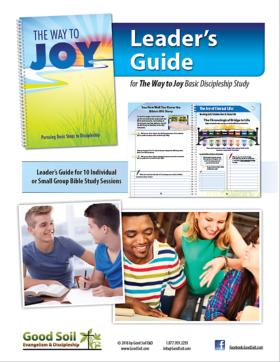Helping Believers “Hold Fast” to the Gospel

But the seed on good soil stands for those with a noble and good heart, who hear the word, retain it, and by persevering produce a crop. (Luke 8:15 – NIV)
If the ultimate “soil test” is whether or not a professing believer retains (“holds fast to”) the word he or she has embraced, can we do anything to help assure that lasting retention occurs? Or, is that simply a personal heart-issue over which we have no influence?
Clearly Understand, Sincerely Embrace, & Firmly Hold On To the Gospel
Earlier in this series of articles, we saw that the New Testament gospel writers used three very different Greek words to define what “good soil” is.
- Matthew 13:23 - “…good soil, this is the one who hears the word and understands it (suniémi).”
- Mark 4:20 - “…good soil are the ones who hear the word and accept (embrace) it (paradechomai) ….”
- Luke 8:15 - “…good soil, they are those who, hearing the word, hold it fast (katecho)….”
As we share the gospel with unbelievers, we can certainly do things to help them understand gospel concepts clearly. And we can take steps to help them embrace it sincerely. But, can we do anything to help them hold on to the gospel they embrace, or is that simply up to them?
We, at Good Soil E&D, believe that if a person clearly understands and sincerely embraces the gospel, and the Savior who is the central focus of the gospel, he or she will persevere (hold on to it).
But, God has chosen to use us (more mature believers) to assist new (or other immature) believers in the process of becoming firmly established in their Christian faith and life.
Discipleship – A Divine-Human Process
The Good Soil Evangelism and Discipleship Scale was presented in an earlier article in this series. The three main vertical columns in the scale depict three responses or roles in the process of evangelism and discipleship:
- People’s (all unbelievers and believers) personal spiritual responses to God and His Word
- Our roles (as personal evangelists and disciplers) in the process of helping other people come to faith in Jesus Christ and then mature as believers
- God’s roles in evangelism and spiritual growth (moving people up the scale)
In evangelism, God uses us to share the gospel with unbelievers, but He is the one who works in their hearts to convict them of sin and regenerate them when they trust Jesus Christ and His redemptive work. So too with the discipleship (development of spiritual maturity) of believers. God is the Ultimate Sanctifier, but He uses us to assist new or weak Christians to “hold fast” to the gospel they have embraced and become firmly grounded in the Christian faith.
Paul explained this to the Corinthian believers:
2 Corinthians 1:24 (NIV)
Not that we lord it over your faith, but we work with you for your joy, because it is by faith you stand firm.
Paul said, it’s “your faith” but I am working with you in order that you may experience joy and stand firm in your faith. It is certainly possible for people to have genuine faith in Jesus Christ but not experience the joy that is possible for them because they are not firmly standing in the faith they have embraced.
As He did with Paul, God can use us to “work with” joy-less, faith-wavering believers to experience full joy and establish a firm stand. The Way to Joy is our Good Soil resource for what we call “first level discipleship” (basic, foundational discipleship) – a discipleship resource designed to help us attempt to achieve the same results that Paul sought with the Corinthian Christians.
The Way to Joy – Pursuing Basic Steps to Discipleship

Uniqueness of The Way to Joy
There are lots of basic discipleship studies available, so why did we create The Way to Joy? Here’s what we call “The Kussel Upper Room Story” that answers this question.
In February 2005, a group of ten missionaries from (literally) all around the world were meeting in a cramped “upper room” of a church in Kussel, Germany. Their task was to strategize how ABWE (Association of Baptists for World Evangelism) could more effectively train missionaries for cross-culturally evangelism and discipleship. One of the discussion leaders asked the question, “What resource do you use for basic follow-up discipleship?” Every member of the group shared his/her response to that question. But, in doing so everyone added a caveat regarding one or more content deficiencies in the resource he/she was using, such as:
- “It doesn’t deal with baptism.”
- “It doesn’t stress the importance of being a member of a local church.”
- “It doesn’t deal with believers’ eternal security in Jesus Christ.”
- “It doesn’t challenge new believers to become involved in ministry, maybe even missionary ministry.”
After hearing these responses, the leader said, “Maybe we ought to create our own basic discipleship resource.” “If you will give me the topics you think NEED to be included in a basic discipleship resource, I’ll see to it that it is created.” Within five months the first edition of The Way to Joy was in print.
Contents of The Way to Joy

Lesson 1 – The Joy of Hope consists of an overview of the Bible’s BIG Story, based on 20 key redemptive story events, from Genesis through Revelation. This lesson is a shorter version of the chronological Bible story found in The Story of Hope (20 events, as compared to 40 events).
Lesson 2 – The Joy of Eternal Life introduces the discipleship student to the Chronological Bridge to Life that was the topic in an earlier article in this series.
The first two lessons serve multiple functions – they help new (professing) believers see and understand an overview of the Bible, but they also help to clarify whether or not the student in the study has truly understood and embraced the gospel before moving on through the remainder of the study which deals with various spiritual disciplines and Christian responsibilities.
Lesson 3 – The Joy of Confidence focuses on assurance of salvation and eternal security.
Lesson 4 – The Joy of Guidance is designed to help new believers understand the importance of God’s Word in their lives and get them started with daily Bible reading and journaling.
Lesson 5 – The Joy of Communion is similar to lesson 4 but focuses on prayer.
Lesson 6 – The Joy of Empowerment explains the role of the Holy Spirit in the life of a Christian.
Lesson 7 – The Joy of Purity teaches the importance of personal holiness and how to deal with sin in a believer’s life.
Lesson 8 – The Joy of Sharing deals with what we typically call “witnessing” or “sharing your faith.”
Lesson 9 – The Joy of Fellowship stresses the importance of the local church in the life of a Christian.
Lesson 10 – The Joy of Purpose emphasizes that God has saved us to serve and the lesson challenges believers to become actively involved in some kind of ministry.
The 64-page, plastic spiral-bound The Way to Joy also includes a Bible reading and prayer journal. Another valuable feature is a set of memory verse cards to be used in the lessons, as well as the key Bible verses associated with the Chronological Bridge to Life.
A FREE downloadable Leader’s Guide is available for use with The Way to Joy. This guide provides answers to the questions in The Way to Joy workbook, as well as suggestions for leading a one-on-one or small group basic discipleship study.
Also, a FREE Class Facilitator’s Guide is available. This guide was created to help you teach The Way to Joy in a classroom setting, such as a class on basic discipleship, perhaps for new believers or baptismal candidates. It is a complete curriculum plan for 13 lessons, including creative learning activities.
Previous articles in this series:
- Three Greek Verbs Define Good Soil
- Assessing Unbeliever’s Gospel Understanding
- Assessing Gospel Receptivity
- Initial Contact or Relational Evangelism—or Both?
- The Problem of Gospel Static
- One Gospel - Three Worldviews
- Worldview “Noisy” Neighborhoods
- How To Understand Worldviews: I’m an Onion – You’re an Onion
- How To Witness to A Non Believer: 3 Step Guide To Using Verbal & Non Verbal Communication
- Gospel Knowledge Deficiencies
- The Romans Road in “Post-Christian” North America?
- Gospel Tracts in “Post-Christian” North America?
- Evangelism that BEGINS with Jesus – Good or Not So Good?
- Explaining the Gospel – Where Did Jesus Begin?
- Change the Way We Do Evangelism in North America?
- Evangelism – For the Biblically Uninformed
- A Distinctive Evangelistic Bible Study Workbook
- How Many Stories in the Bible?
- Eight Words Summarize the Bible’s BIG Story
- Gotta Pray the Sinner’s Prayer?
- Repent and/or Believe? Two Steps or Two Sides?

The Way to Joy is a leader-guided foundational Bible study book, intended primarily for use as an evangelistic follow-up discipleship study but is appropriate for any believer beginning to be serious about his or her Christian faith-journey. Its primary intended use is for one-to-one discipleship sessions. However, it can also be used in small group contexts or as a study book for classes with new converts, new church members, or others who are interested in topics of importance to basic discipleship. There are FREE downloadable leader guides for use in both kinds of settings.
The ten lessons in The Way to Joy focus on an overview of God's redemptive plan, the Chronological Bridge to Life, assurance and security of salvation, the Bible, prayer, the Holy Spirit, personal holiness, witnessing, the local church, and God's plan for our lives.
Unlike some books of this type, The Way to Joy provides provocative questions to stimulate discipling conversations between the leader and the learner. It is beautifully illustrated with customized full-color visual illustrations. In addition to the 64 pages of discipleship content, a set of Bible memory verse cards is included in each book... Learn more.
FREE Downloads: The Way to Joy Leader's Guide and Class Facilitator's Guide.






